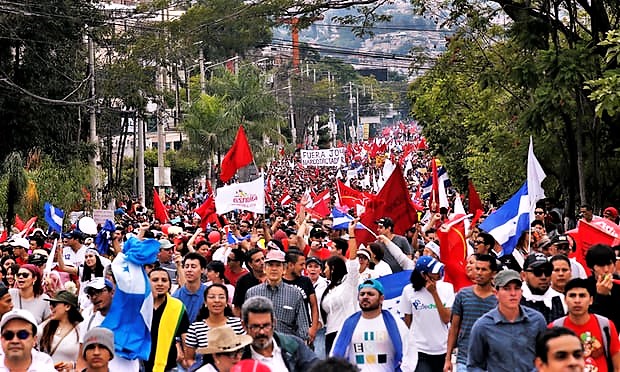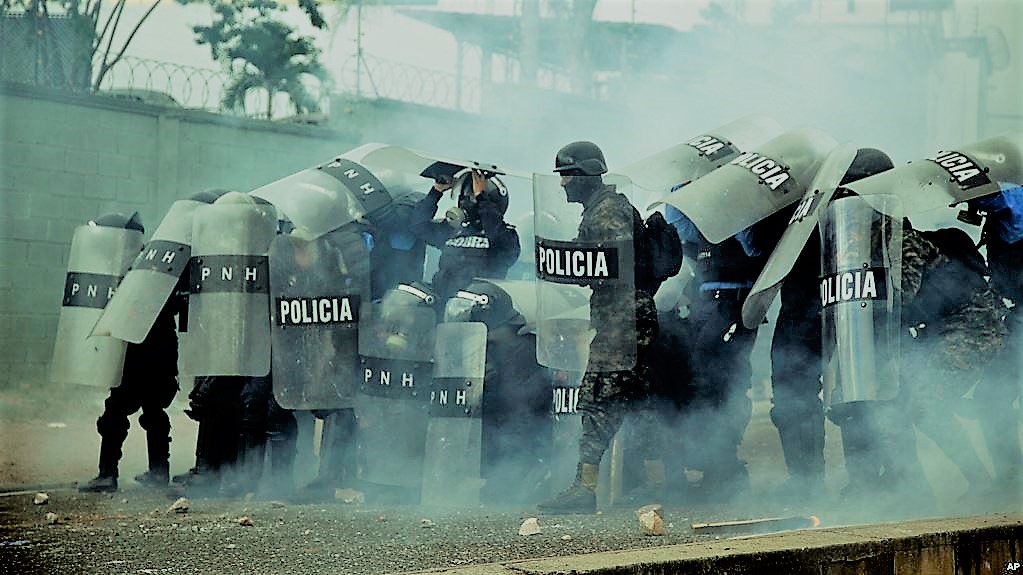The November 2017 election-fraud, dictatorship-today, U.S.- and Canada-supported, crisis in Honduras has considerable historic precedence, elucidated by anthropologist Rosemary Joyce. Not a pretty scenario, with no easy solution to preventing Honduras from repeating past horrors and falling into a lasting period of military rule that marginalizes people, violently suppresses dissent, and brutalizes ecosystems.


Dictatorship: the ghost that haunts re-election in Honduras
By Rosemary Joyce. Published in Honduras Culture and Politics
The tweet from @Codigo504 is the kind of mordant humor I think of as typically Honduran:
Después del informe de OEA y el tuitazo de Almagro los cachurecos deben calcular bien sus próximas acciones. #CariasQueHubieraHecho?
After OAS’ report and Almagro’s tweet, the Cachurecos need to think very carefully about their next steps #WhatWouldCariasDo?#JOHNotMyPresident
— Codigo504 (@Codigo504) December 18, 2017
“What Would (Tiburcio) Carías Do?”
That’s easy: hold on to power however he could. Tiburcio Carías Andino is the ghost hovering over presidential re-election in Honduras.
While the rhetoric used to justify the 2009 made re-election especially potent as a current political issue, the constitutional ban on re-election is not a long-established Honduran practice. It was inserted in the 1982 constitution that Oscar Arias famously called the “worst in the entire world” during his failed attempt to negotiate an end to the 2009 crisis.
One of the daughters of Berta Caceres responds to the Military Curfew imposed by the U.S. and Canadian-backed regime of Juan Orlando Hernandez (JOH) and the National Party in Honduras, on behalf of the people of La Esperanza, Intibuca.
The 1982 constitution was enacted as part of the exit from a long period of military rule, guided by the relationship of Honduras and the United States. One of the new features was the declaration in the Constitution that certain provisions could not be amended, including the prohibition on re-election and the definition of the term of the presidency as four years. These features have been described as “centerpieces” of the new 1982 constitution.
Why such an insistence that no future president would serve more than four years? It might seem at first that this was intended to forestall the kind of military dictatorships that had dominated Honduras from 1963 to 1982 (with a brief hiatus for an elected government lasting just over a year from 1971-1972). But that is too short a time frame to understand this provision.


Tiburcio Carías Andino is the ghost hanging over the understanding of the potential for a Honduran President to exploit electoral laws to hang on to power indefinitely. The Honduran people see Juan Orlando Hernández as seeking to follow the path of Carías, not of Policarpo Paz.
Carías Andino first took supreme executive control of Honduras in 1924, during a period of substantial political conflict. In 1932, he ran for election and started an unprecedented period of 16 years in that office. The constitution in force at the time prohibited consecutive terms as President, so Carías Andino initiated the writing of a new constitution. This allowed him to stay in office, and consolidate executive control.
STORY: In Honduras, U.S. Guilty of Financing Dictatorship
The U.S. has been working behind the scenes for weeks urging the Honduran opposition to shut down protests. — Allan Nairn in The Intercept
Carías suppressed political opposition. His power ended in part due to protests that began in the capital city and in San Pedro Sula. In the latter case, the brutal suppression of the protests shaped a generation of political activists.
In the aftermath of his presidency, Honduras experienced a significant turmoil, starting with a presidential term by Carías hand-picked successor, Juan Manuel Gálvez. Toward the end of his term in office, a major strike against the dominant banana industry transformed the country, showing the power of labor.
The 1954 election for president did not produce a candidate with the then-required majority vote. (A majority is no longer required by the 1982 constitution, leading to the election in 2013 of a president who received less than 38% of the popular vote, and contributing to the crisis of 2017. This non-majority clause can be seen as another haunting from the age of Carías Andino.)
In 1954, the resolution of the election was messy: the legislature was supposed to vote to decide who would be president, requiring a two-thirds majority. Two parties boycotted the required sessions, preventing this resolution. The Supreme Court was supposed to resolve a legislative failure to decide, but it was perceived as illegitimate due to being packed by Carías Andino. (Legislative packing of the Supreme Court by Hernández facilitated the decision that opened the way to his seeking re-election, another piece of the Carías playbook that he emulated.)
In the void of power, the vice president, Julio Lozano Díaz, took over, suspending the congress and instituting the writing of a new constitution. His extra-legal regime lasted two years, ending with a military coup. The candidate from 1954 who had received the most votes, Ramón Villeda Morales, was elected to a six-year term in 1957.
Villeda Morales initiated modernizing policies including modest agrarian reforms. By the end of his term, these led to opposition from conservative sectors of Honduran society. Under the constitution then in force, Villeda Morales himself was limited to one six year term as president. His party’s nominee was expected to win, however, and to continue his policies.
That prospect was enough to initiate a military coup. The seizure of government initiated the long period that only ended in 1982 with the ratification of the current constitution. Its provisions about presidential election are shaped by the history that began with Carías Andino: a single term for president, without re-election, and no requirement for a majority, a run-off election, or any mechanism for resolving elections too close to truly be called like the one that once threw election to the Congress and then the Supreme Court.
Protesters have been blockading highways and key city arteries in San Pedro Sula, El Progreso, Choloma, Villanueva and neighboring areas day and night. State security forces have been terrorizing neighborhoods and opening fire indiscriminately, shooting and killing protesters and residents on a near-daily basis. Some protesters have been fighting back, though most “clashes” have entailed people throwing rocks and other projectiles at security forces armed with assault rifles, or burning down police stations and other property damage. — Sandra Cuffe, in Toward Freedom
The US government in 1963, under the direction of President John F. Kennedy, cancelled aid, withdrew US military from Honduras, and called the Ambassador to Honduras back to the US. None of these actions led to the return of control to civilian government. General Oswaldo López Arrellano, who held power until 1971 and again from 1972 to 1975, eventually initiated new agrarian reforms, before falling out of power due to a bribery scandal involving the United Fruit Company.
His two successors, also military officers holding extra-judicial power, consolidated the ideology of the military as a stabilizing force that led to their institutionalization in the current constitution as the guarantors of democratic processes. That constitutional role was cited by the military as motivation for their actions in the 2009 coup d’etat.
Hernández has worked to make the army loyal to him. He has also invested, with substantial US aid, in the creation of new militarized police whose role in the 2013 election already was seen as promoting repression. The history of presidential manipulation of the armed forces, too, can be traced back to the Carías dictatorship that is providing so much of the model for the current president.
So indeed, the question #WhatWouldCariasDo appears to be the one that we all should be asking as we watch to see what tactics the modern successor to the authoritarian who scarred Honduran political memory might adopt.
Rosemary A. Joyce is a professor of anthropology whose entire career has been spent conducting research in and on Honduras.








